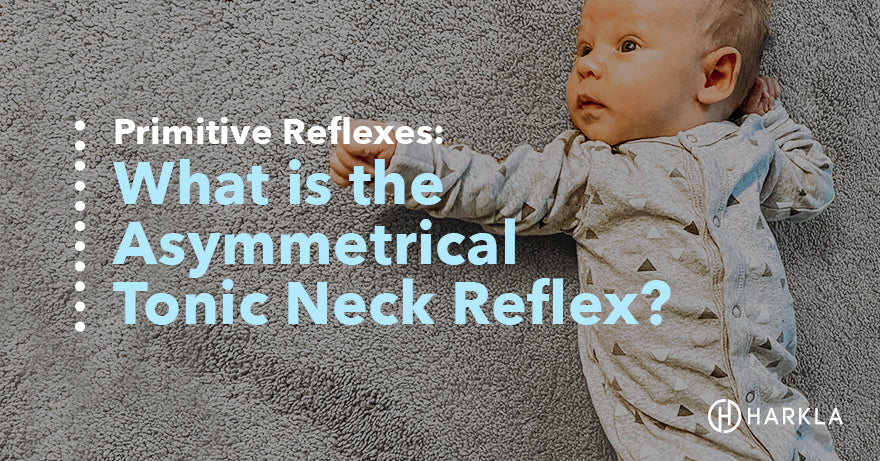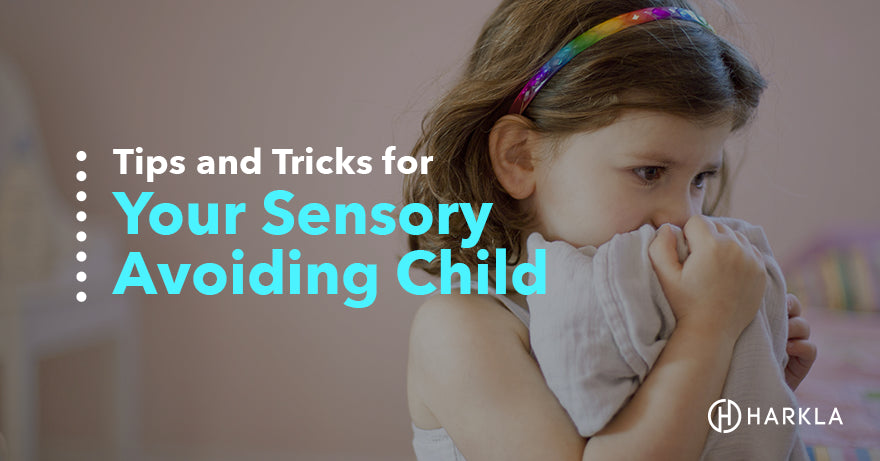Your Cart is Empty

The ATNR reflex (Asymmetrical Tonic Neck Reflex) is one of many primitive reflexes - an involuntary movement pattern that we are all born with. The ATNR is often called the “fencing reflex”, due to the fact that when an infant is lying on their back and their head is turned to one side, the arm on that same side will extend while the opposite arm will flex in towards the body - looks like they’re ready to start fencing!
The ATNR is elicited by a simple head turn to either the right or the left. The kicking that is felt in utero is due to the ATNR! Additionally, the ATNR plays a role in the birthing process by assisting with “unscrewing” down the birth canal. Because the ATNR is elicited with head movement, it is also connected directly to the vestibular system (the vestibular system is activated by head movement and head position changes), which affects balance and muscle tone. Another big role that the ATNR takes part in is hand-eye coordination and developing skills on each side of the body - think of turning your head to reach and grab an item.
The ATNR reflex develops at approximately 18 weeks in utero, should be fully developed by birth, and should integrate by six months of age. This is around the same time that the Moro and Palmar Grasp reflexes are also integrating, as well as around the same time, the infant is intentionally reaching for objects, has gained head control, and may start crawling.
Although there is no one scientific method to ensure full primitive reflex integration, there are some things to take into consideration when discussing ATNR reflex integration.

Let’s talk about sensory integration. By providing an infant with different types of sensory stimulation, new neural pathways will be developed in the brain, thus stimulating new movement and cognitive development. An article on sensory integration discussed that the engagement in sensorimotor activities promoted adaptive behaviors via neuroplastic changes - simply put, by experiencing different types of sensory activities, our brains can change and thus promote new behaviors!
So what types of sensory activities should you provide to your newborn infant? Keep it simple!
Because every newborn is different and every experience is different, there’s no one way to guarantee that the ATNR will be successfully integrated by six months of age. However, you can feel more confident that your baby is getting the sensory experiences necessary for potential primitive reflex integration by using the above strategies.
A study looking at the persistence of primitive reflexes and associated problems in children identified these potential factors for unintegrated primitive reflexes, including the ATNR reflex:
Additionally, if a child has successfully integrated their primitive reflexes, a sudden or chronic bout of trauma, stress or injury can re-activate these reflexes.
While there is no guarantee for reflex integration, there are contributing factors to consider if your child has an unintegrated ATNR.
When integrating ATNR reflex doesn’t happen on time, the body may still respond involuntarily to head movements, affecting coordination and balance. Because the ATNR is directly related to the vestibular system and consists of a physical reaction, it has a direct impact on movement, balance, muscle tone, and coordination. Additionally, due to the movement of the arm in relation to the head, it also has a direct impact on hand-eye coordination.
Symptoms related to an unintegrated ATNR in older children are:
If your child exhibits any of the above symptoms/challenges, the first step will be to talk with your pediatrician. These simple activities and daily habits can support ATNR reflex integration and help your child build stronger neural connections through movement. Discuss your concerns - if your pediatrician is familiar with primitive reflex integration, they may already have a plan of action ready. If your pediatrician is unfamiliar with primitive reflex integration, feel free to share what you've learned! If you ever feel uncomfortable or that your concerns are being pushed to the side don’t be afraid to seek out a new pediatrician.

Many Occupational Therapists (OT) are trained in primitive reflex integration techniques. Seek one out! Talk with friends and family members to see if they know anyone specific. Use Facebook groups and Instagram to find someone who has training. Physical Therapists (PT), cranio-sacral therapists, and chiropractors may also have knowledge of primitive reflex integration. It can take some time to locate the right professional, so don’t give up!
Meanwhile, there are some different exercises and play activities that you can incorporate into your child’s daily routine that can help promote the integration of the ATNR.
For babies, decreasing the amount of waking time spent in containers is the best way to integrate the ATNR. These are things like bouncers, jumpers, walkers, etc. When baby is awake, provide natural movement opportunities, plenty of tummy time, and opportunities to visually track objects in their environment. If safety is a concern during tummy time, opt for something like a pack and play instead of a container that doesn’t allow for natural movement.
If your child is young, under three years old, focus on developmental movements and visual tracking.
If your child is older, you can still focus on the same developmental movements and increase the challenges, as well as try some other activities.
If your child is struggling with some of the signs/symptoms associated with an unintegrated ATNR, try some of these strategies:
If your child still shows signs of an unintegrated ATNR reflex, don’t worry, there are gentle, play-based activities that can help. These ATNR reflex integration exercises are simple ways to encourage natural movement patterns that support brain and body coordination.
Always talk to your pediatrician or occupational therapist before starting new exercises, especially if your child has medical or developmental concerns.
1. Head Turn Tracking
Have your baby lie on their back. Slowly move a colorful toy or soft rattle from the center to the left, then back to the center, and then to the right. This encourages full head turns — one of the main ways of integrating ATNR reflex.
2. Tummy Time Reaches
During tummy time, place toys on both sides of your baby’s body. Encourage them to reach across midline to grab the toy, which strengthens coordination between both sides of the body and supports ATNR reflex integration.
3. Cross-Crawl Movement
Once your child is crawling or walking, try “cross crawls”, touching the right elbow to the left knee, then switching sides. This bilateral movement helps the brain connect both hemispheres and naturally aids in integrating the ATNR reflex.
4. “Fencing” Play Position
Place your baby on their back and gently help them into the fencing posture — one arm extended and the other flexed, then switch sides slowly. This helps the body experience and integrate the ATNR reflex pattern in a safe, controlled way.
5. Visual Tracking with Movement
Use light-up or musical toys to engage your child’s visual system. Encourage them to turn their head slowly to follow the object while keeping their body stable. This improves both head control and ATNR reflex integration through sensory coordination.
These ATNR reflex integration exercises can be done for a few minutes each day. Keep sessions short, fun, and responsive to your child’s comfort level. Over time, regular practice supports smoother motor control, balance, and confidence in movement.
As you continue on your path through primitive reflex integration, keep in mind that your child is unique, and there's nothing wrong with them! Even if they have an unintegrated ATNR and seem to be struggling more than other children, your job is to help guide them along the way and provide as much support as possible.
You and your child are doing the best you can with what you have, so keep researching and keep trying new things until you find what works. Even then, keep searching because what works now might not work forever, especially as your child grows and develops through different seasons of life!
The ATNR reflex, or Asymmetrical Tonic Neck Reflex, is an automatic movement pattern that helps newborns develop coordination and balance.
The ATNR reflex usually integrates around 6 months of age, although this can vary slightly from baby to baby.
Tummy time, crawling, and cross-body play are some of the most effective ATNR reflex integration exercises for supporting early motor development.
If the ATNR reflex remains active past infancy, it can affect posture, balance, or reading and writing coordination. Occupational therapy can help support integrating ATNR reflex naturally.
Do you prefer to listen to your content? Check out our podcast episode where we discuss ATNR!
Want to become an expert on Primitive Reflexes?
Be sure to check out our full Primitive Reflex Integration Training!
Comments will be approved before showing up.

